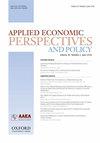时间和空间上的贫困预测和目标:来自尼日利亚的证据
IF 3.4
2区 经济学
Q2 AGRICULTURAL ECONOMICS & POLICY
引用次数: 0
摘要
了解贫困动态对尼日利亚等发展中国家的经济政策的针对性和针对性至关重要。尼日利亚面临着容纳全球约四分之一贫困人口的风险。为了促进减贫干预措施的针对性,我们建立了一个涵盖2011-2019年的全国代表性面板数据集,其中包含100多个协变量,并应用计量经济学和机器学习工具来预测和检查与尼日利亚家庭静态、短暂和持续贫困状况相关的因素。结果表明,人口因素、资产持有、基础设施获取和住房指标在80%的情况下可以准确预测贫困。本文章由计算机程序翻译,如有差异,请以英文原文为准。
Poverty prediction and targeting over time and space: Evidence from Nigeria
Understanding poverty dynamics is crucial to target and tailor economic policies in developing countries like Nigeria—a country at the risk of hosting about a quarter of all people living in poverty worldwide. To facilitate the targeting of poverty-reducing interventions, we build a nationally representative panel dataset spanning 2011–2019 with more than a hundred covariates and apply econometric and machine learning tools to predict and examine factors associated with the static, transient, and persistent poverty status of Nigerian households. Results show that demographic factors, asset holdings, access to infrastructure, and housing indicators can accurately predict poverty in 80% of cases.
求助全文
通过发布文献求助,成功后即可免费获取论文全文。
去求助
来源期刊

Applied Economic Perspectives and Policy
AGRICULTURAL ECONOMICS & POLICY-
CiteScore
10.70
自引率
6.90%
发文量
117
审稿时长
>12 weeks
期刊介绍:
Applied Economic Perspectives and Policy provides a forum to address contemporary and emerging policy issues within an economic framework that informs the decision-making and policy-making community.
AEPP welcomes submissions related to the economics of public policy themes associated with agriculture; animal, plant, and human health; energy; environment; food and consumer behavior; international development; natural hazards; natural resources; population and migration; and regional and rural development.
 求助内容:
求助内容: 应助结果提醒方式:
应助结果提醒方式:


